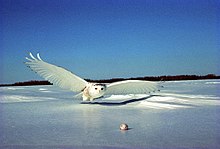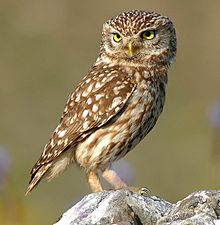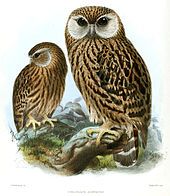Owls are a group of
birds that belong to the
order Strigiformes, constituting 200 extant
bird of prey species. Most are
solitary and
nocturnal, with some exceptions (e.g., the
Northern Hawk Owl). Owls hunt mostly small
mammals,
insects, and other birds, although a few species specialize in hunting
fish. They are found in all regions of the Earth except
Antarctica, most of
Greenland, and some remote islands. Owls are characterized by their small beaks and wide faces, and are divided into two
families: the
typical owls, Strigidae; and the
barn-owls, Tytonidae.
Anatomy
Owls have large forward-facing eyes and ear-holes; a
hawk-like
beak; a flat face; and usually a conspicuous circle of feathers, a
facial disc,
around each eye. The feathers making up this disc can be adjusted in
order to sharply focus sounds that come from varying distances onto the
owls' asymmetrically placed ear cavities. Most birds of prey sport eyes
on the sides of their heads, but the stereoscopic nature of the owl's
forward-facing eyes permits the greater sense of depth perception
necessary for low-light hunting. Although owls have
binocular vision,
their large eyes are fixed in their sockets—as are those of other
birds—so they must turn their entire head to change views. As owls are
farsighted, they are unable to see clearly anything within a few
centimeters of their eyes. Caught prey can be felt by owls with the use
of
filoplumes—like feathers on the beak and feet that act as "feelers". Their far vision, particularly in low light, is exceptionally good.
Owls can rotate their heads and necks as much as 270 degrees. Owls
have fourteen neck vertebrae as compared to 7 in humans which makes
their necks more flexible. They also have adaptations to their
circulatory systems, permitting rotation without
cutting off blood to the brain:
the foramina in their vertebrae through which the vertebral arteries
pass are about 10 times the diameter of the artery, instead of about the
same size as the artery as in humans; the vertebral arteries enter the
cervical vertebrae higher than in other birds, giving the vessels some slack; and the
carotid arteries unite in a very large
anastomosis
or junction, the largest of any bird's, preventing blood supply from
being cut off while the neck is rotated. Other anastomoses between the
carotid and vertebral arteries support this effect.
[1][2]
The smallest owl—weighing as little as 31 grams (1 oz) and measuring some 13.5 centimetres (5 in)—is the
Elf Owl (
Micrathene whitneyi).
[3] Around the same diminutive length, although slightly heavier, are the lesser known
Long-whiskered Owlet (
Xenoglaux loweryi) and
Tamaulipas Pygmy Owl (
Glaucidium sanchezi).
[3] The largest owl by length is the
Great Grey Owl (
Strix nebulosa), which measures around 70 cm (28 in) on average and can attain a length of 84 cm (33 in).
[3] However, the heaviest (and largest winged) owls are two similarly-sized
eagle owls; the
Eurasian Eagle-Owl (
Bubo bubo) and
Blakiston's Fish Owl (
B. blakistoni).
These two species, which are on average about 2.53 cm (1.00 in) shorter
in length than the Great Grey, can both attain a wingspan of 2 m
(6.6 ft) and a weight of 4.5 kg (10 lb) in the largest females.
[3][4][5][6][7]
Different species of owls make different sounds; this wide range of
calls aids owls in finding mates or announcing their presence to
potential competitors, and also aids
ornithologists and
birders
in locating these birds and recognizing species. As noted above, the
facial disc helps owls to funnel the sound of prey to their ears. In
many species, these discs are placed asymmetrically, for better
directional location.
[8][verification needed]
The
plumage
of owls is generally cryptic, but many species have facial and head
markings, including face masks, ear tufts and brightly coloured
irises.
These markings are generally more common in species inhabiting open
habitats, and are thought to be used in signaling with other owls in low
light conditions.
[9]
Breeding and reproduction
Owl eggs usually have a white color and an almost spherical shape,
and range in number from a few to a dozen, depending on species and the
particular season; for most, three or four is the more common number.
Eggs are laid at intervals of 1 to 3 days and do not hatch at the same
time.
[citation needed]
Behavior
Most owls are
nocturnal, actively hunting their prey only in darkness. Several types of owl, however, are
crepuscular—active during the twilight hours of
dawn and
dusk; one example is the
Pygmy owl (
Glaucidium). A few owls are active during the day also; examples are the
Burrowing Owl (
Speotyto cunicularia) and the
Short-eared Owl (
Asio flammeus).
Much of the owls' hunting strategy depends on stealth and surprise.
Owls have at least two adaptations that aid them in achieving stealth.
First, the dull coloration of their' feathers can render them almost
invisible under certain conditions. Secondly, serrated edges on the
leading edge of owls'
remiges
muffle an owl's wing beats, allowing an owl's flight to be practically
silent. Some fish-eating owls, for which silence has no evolutionary
advantage, lack this adaptation.
An owl's sharp
beak and powerful
talons
allow it to kill its prey before swallowing it whole (if it is not too
big). Scientists studying the diets of owls are helped by their habit of
regurgitating the indigestible parts of their prey (such as bones, scales and fur) in the form of
pellets.
These "owl pellets" are plentiful and easy to interpret, and are often
sold by companies to schools for dissection by students as a lesson in
biology and ecology.
[10]
Adaptations for hunting
All owls are carnivorous birds of prey and live mainly on a diet of
insects and small rodents such as mice, rats and hares. Some owls are
also specifically adapted to hunt fish. They are very adept in hunting
in their respective environments. Since owls can be found in nearly all
parts of the world and across a multitude of ecosystems, their hunting
skills and characteristics vary slightly from species to species, though
most characteristics are shared among all species.
[citation needed]
Flight and feathers
Most owls share an innate ability to fly almost silently and also
more slowly in comparison to other birds of prey. Most owls live a
mainly nocturnal lifestyle and being able to fly without making any
noise gives them a strong advantage over their prey that are listening
for any sign of noise in the dark night. A silent, slow flight is not as
necessary for diurnal and crepuscular owls given that prey can usually
see an owl approaching. While the morphological and biological
mechanisms of this silent flight are more or less unknown, the structure
of the feather has been heavily studied and accredited to a large
portion of why they have this ability. Owls’ feathers are generally
larger than the average birds’ feathers, have fewer radiates, longer
pennulum, and achieve smooth edges with different
rachis structures.
[11]
Serrated edges along the owl’s remiges bring the flapping of the wing
down to a nearly silent mechanism. Research has shown that the
serrations are more likely reducing aerodynamic disturbances, rather
than simply reducing noise.
[11]
The surface of the flight feathers is covered with a velvety structure
that absorbs the sound of the wing moving. These unique structures
reduce noise frequencies above 2 kHz,
[12] making the sound level emitted drop below the typical hearing spectrum of the owl’s usual prey
[12][13] and also within the owl’s own best hearing range
[citation needed].
This optimizes the owl’s ability to silently fly in order to capture
prey without the prey hearing the owl first as it flies in. It also
allows the owl to monitor the sound output from its flight pattern.
Vision
Another characteristic of the owl which aids in their nocturnal prey
capture is their eyesight. Owls are part of a small group of birds that
live nocturnally, but do not use
echolocation
to guide them in flight in low-light situations. Owls are known for
their disproportionally large eyes in comparison to their skull. An
apparent consequence of the evolution of an absolutely large eye in a
relatively small skull is that the eye of the owl has become tubular in
shape.
[14] This shape is found in other so-called nocturnal eyes, such as the eyes of
prosimians and
bathypelagic fishes.
[15] Since the eyes are fixed into these sclerotic tubes, they are unable to move the eyes in any direction.
[16]
Instead of moving their eyes, owls swivel their head to visualize their
surroundings. Owl’s heads are capable of swiveling through an angle of
approximately 270°, easily enabling them to see behind them without
relocating the torso.
[16]
This ability keeps bodily movement at a minimum and thus reduces the
amount of sound the owl makes as it waits for its prey. Owls are
regarded as having the most frontally placed eyes among all avian
groups, which gives them some of the largest binocular fields of vision.
But owls are farsighted and cannot focus on objects within a few
centimeters of their eyes.
[15][17]
While it is commonly believed that owls have such great nocturnal
vision due to their large (and thus very light-gathering) eyes and
pupils and/or extremely sensitive rod receptors, the true cause for
their ability to see in the night is due to neural mechanisms which
mediate the extraction of spatial information gathered from the retinal
image throughout the nocturnal luminance range. These mechanisms are
only able to function due to the large sized retinal image.
[18]
Thus, the primary nocturnal function in the vision of the owl is due to
its large posterior nodal distance; retinal image brightness is only
maximized to the owl within secondary neural functions.
[18] These attributes of the owl cause the nocturnal eyesight to be far superior to that of its average prey.
[18]
Hearing
Owls exhibit specialized hearing functions and ear shapes that also
aid in hunting. They are noted for asymmetrical ear placements on the
skull in some genera. Owls can have either internal or external ears,
but those genera exhibiting asymmetrical ear geometry only have external
ear placements. Asymmetry has not been reported to extend to the middle
or internal ear of the owl. Asymmetrical ear placement on the skull
allows the owl to pinpoint the location of its prey. This is especially
true for strictly nocturnal species such as the barn owls 'Tyto' or
Tengmalm’s Owl.
[16]
With ears set at different places on its skull, an owl is able to
determine the direction from which the sound is coming by the minute
difference in time that it takes for the sound waves to penetrate the
left and right ears.
[citation needed]
The owl turns its head until the sound reaches both ears at the same
time, at which point it is directly facing the source of the sound. This
time difference between ears is a matter of about 0.00003 seconds, or
30 millionths of a second. Like the eyes, which utilize feather
movements to focus light, the ears are surrounded by feathers to
maximize hearing capabilities. Behind the ear openings there are
modified, dense feathers, densely packed to form a facial ruff, which
creates an anteriorly-facing concave wall that cups the sound into the
ear structure.
[19]
This facial ruff is poorly defined in some species and prominent,
nearly encircling the face, in other species. The facial disk also acts
to direct sound into the ears, and a downward-facing, sharply triangular
beak minimizes sound reflection away from the face. The shape of the
facial disk is adjustable at will to focus sounds more effectively.
[16]
Talons
While the auditory and visual capabilities of the owl allow it to
locate and pursue its prey, the talons and beak of the owl do the final
work. The owl kills its prey by using these talons to crush the skull
and knead the body.
[16] The crushing power of an owl’s talons varies according to prey size and type, and by the size of the owl. The
Burrowing Owl (
Athene cunicularia), a small partly insectivorous owl, has a release force of only 5 N. The larger
Barn Owl (
Tyto alba) needs a force of 30 N to release its prey, and one of the largest owls, the
Great Horned Owl (
Bubo virginianus) needs a force of over 130 N to release prey in its talons.
[20] An owl’s talons, like those of most birds of prey, can seem massive in comparison to the body size outside of flight. The
Masked owl
has some of the proportionally longest talons of any bird of prey; they
appear enormous in comparison to the body when fully extended to grasp
prey.
[21]
An owl’s claws are sharp and curved. The family Tytonidae have inner
and central toes of about equal length, while the family Strigidae have
an inner toe that is distinctly shorter than the central one.
[20] These different morphologies allow efficiency in capturing prey specific to the different environments they inhabit.
Beak
The beak of the owl is short, curved and downward-facing, and
typically hooked at the tip for gripping and tearing its prey. Once prey
is captured, the scissor motion of the top and lower bill is used to
tear the tissue and kill. The sharp lower edge of the upper bill works
in coordination with the sharp upper edge of the lower bill to deliver
this motion. The downward-facing beak allows the owl’s field of vision
to be clear, as well as directing sound into the ears without deflecting
sound waves away from the face.
[citation needed]

Snowy Owl blends well with its snowy surroundings
Camouflage
The coloration of the owl’s plumage plays a key role in its ability
to sit still and blend into the environment, making it nearly invisible
to prey. Owls tend to mimic the colorations and sometimes even the
texture patterns of their surroundings, the common barn owl being an
exception.
Nyctea scandiaca, or the
Snowy Owl,
appears nearly bleach-white in color with a few flecks of black,
mimicking their snowy surroundings perfectly. Likewise, the Muted
Wood-Owl (
Strix ocellata) displays shades of brown, tan and
black, making the owl nearly invisible in the surrounding trees,
especially from behind. Usually, the only tell-tale sign of a perched
owl will be its vocalizations or its vividly colored eyes.
Evolution and systematics
The
systematic placement of owls is disputed. For example, the
Sibley-Ahlquist taxonomy finds that, based on
DNA-DNA hybridization, owls are more closely related to the
nightjars and their allies (
Caprimulgiformes) than to the diurnal predators in the order
Falconiformes; consequently, the Caprimulgiformes are placed in the Strigiformes, and the owls in general become a
family Strigidae.
A recent study indicates that the drastic rearrangement of the genome
of the accipitrids may have obscured any close relationship of theirs
with groups such as the owls.
[22] In any case, the relationships of the Caprimulgiformes, the owls, the
falcons and the
accipitrid raptors
are not resolved to satisfaction; currently there is an increasing
trend to consider each group (with the possible exception of the
accipitrids) a distinct order.
There are some 220 to 225 extant species of owls, subdivided into two families:
typical owls (Strigidae) and
barn-owls (Tytonidae). Some entirely extinct families have also been erected based on
fossil
remains; these differ much from modern owls in being less specialized
or specialized in a very different way (such as the terrestrial
Sophiornithidae). The
Paleocene genera
Berruornis and
Ogygoptynx show that owls were already present as a distinct lineage some 60–57 mya (
million years ago), and, hence, possibly also some 5 million years earlier, at the extinction of the non-avian
dinosaurs. This makes them one of the oldest known groups of non-
Galloanserae landbirds. The supposed "
Cretaceous owls"
Bradycneme and
Heptasteornis are apparently non-
avialan maniraptors.
[23]
During the
Paleogene, the Strigiformes
radiated into
ecological niches now mostly filled by other groups of birds.
[clarification needed] The owls as we know them today, on the other hand, evolved their characteristic
morphology and
adaptations during that time, too. By the early
Neogene,
the other lineages had been displaced by other bird orders, leaving
only barn-owls and typical owls. The latter at that time were usually a
fairly generic type of (probably earless) owl similar to today's North
American
Spotted Owl or the European
Tawny Owl; the diversity in size and
ecology found in typical owls today developed only subsequently.
Around the Paleogene-Neogene boundary (some 25
mya),
barn-owls were the dominant group of owls in southern Europe and
adjacent Asia at least; the distribution of fossil and present-day owl
lineages indicates that their decline is contemporary with the evolution
of the different major lineages of typical owls, which for the most
part seems to have taken place in Eurasia. In the Americas, there was
rather an expansion of immigrant lineages of ancestral typical owls.
The supposed fossil
herons "Ardea" perplexa (Middle Miocene of Sansan, France) and
"Ardea" lignitum (Late Pliocene of Germany) were more probably owls; the latter was apparently close to the modern genus
Bubo. Judging from this, the Late Miocene remains from France described as
"Ardea" aureliensis should also be restudied.
[24] The
Messelasturidae, some of which were initially believed to be
basal Strigiformes, are now generally accepted to be diurnal
birds of prey showing some
convergent evolution towards owls. The taxa often united under
Strigogyps[25] were formerly placed in part with the owls, specifically the Sophiornithidae; they appear to be
Ameghinornithidae instead.
[26][27][28]
For fossil species and
paleosubspecies of extant
taxa, see the genus and species articles.
Unresolved and basal forms (all fossil)
- Berruornis (Late Paleocene of France) basal? Sophornithidae?
- Strigiformes gen. et ap. indet. (Late Paleocene of Zhylga, Kazakhstan)
- Palaeoglaux (Middle – Late Eocene of WC Europe) own family Palaeoglaucidae or Strigidae?
- Palaeobyas (Late Eocene/Early Oligocene of Quercy, France) Tytonidae? Sophiornithidae?
- Palaeotyto (Late Eocene/Early Oligocene of Quercy, France) Tytonidae? Sophiornithidae?
- Strigiformes gen. et spp. indet. (Early Oligocene of Wyoming, USA)[24]
Ogygoptyngidae
- Ogygoptynx (Middle/Late Paleocene of Colorado, USA)
Protostrigidae
- Eostrix (Early Eocene of WC USA and England - Middle Eocene of WC USA)
- Minerva (Middle - Late Eocene of W USA) formerly Protostrix, includes "Aquila" ferox, "Aquila" lydekkeri, and "Bubo" leptosteus
- Oligostrix (mid-Oligocene of Saxony, Germany)
Sophiornithidae
Tytonidae: Barn-owls
- Genus Tyto – typical barn-owls, stand up to 500 millimetres (20 in) tall. Some 15 species and possibly one recently extinct
- Genus Phodilus – bay-owls, 1–2 extant species and possibly one recently extinct
Fossil genera
- Nocturnavis (Late Eocene/Early Oligocene) includes "Bubo" incertus
- Selenornis (Late Eocene/Early Oligocene) - includes "Asio" henrici
- Necrobyas (Late Eocene/Early Oligocene – Late Miocene) includes "Bubo" arvernensis and Paratyto
- Prosybris (Early Oligocene? – Early Miocene)
Placement unresolved
- Tytonidae gen. et sp. indet. "TMT 164" (Middle Miocene) – Prosybris?
Strigidae: Typical owls
- Aegolius – saw-whet owls, four species
- Asio – eared owls, 67 species
- Athene – 2–4 species (depending on whether Speotyto and Heteroglaux are included or not)
- Bubo – horned owls, eagle-owls and fish-owls; paraphyletic with Nyctea, Ketupa, and Scotopelia, some 25 species
- Ciccaba – four species
- Glaucidium – pygmy-owls, about 30–35 species
- Grallistrix – stilt-owls, four species; prehistoric
- Gymnoglaux – Bare-legged Owl or Cuban Screech-owl
- Jubula – Maned Owl
- Lophostrix – Crested Owl
- Mascarenotus – Mascarene owls, three species; extinct (c.1850)
- Megascops – screech-owls, some 20 species
- Micrathene – Elf Owl
- Mimizuku – Giant Scops-owl or Mindanao Eagle-owl
- Ninox – Australasian hawk-owls, some 20 species
- Nesasio – Fearful Owl
- Ornimegalonyx – Caribbean giant owls, 1–2 species; prehistoric
- Otus – scops-owls; probably paraphyletic, about 45 species
- Pseudoscops – Jamaican Owl and possibly Striped Owl
- Ptilopsis – white-faced owls, two species
- Pulsatrix – spectacled owls, three species
- Pyrroglaux – Palau Owl
- Sceloglaux – Laughing Owl; extinct (1914?)
- Strix – earless owls, about 15 species
- Surnia – Northern Hawk-owl
- Uroglaux – Papuan Hawk-owl
- Xenoglaux – Long-whiskered Owlet
Fossil genera
- Mioglaux (Late Oligocene? – Early Miocene of WC Europe) – includes "Bubo" poirreiri
- Intutula (Early/Middle - ?Late Miocene of C Europe) - includes "Strix/Ninox" brevis
- Alasio (Middle Miocene of Vieux-Collonges, France) - includes "Strix" collongensis
- Oraristrix (Late Pleistocene)
Placement unresolved
- "Otus/Strix" wintershofensis: fossil (Early/Middle Miocene of Wintershof West, Germany) - may be close to extant genus Ninox[24]
- "Strix" edwardsi – fossil (Middle/Late? Miocene)
- "Asio" pygmaeus – fossil (Early Pliocene of Odessa, Ukraine)
- Strigidae gen. et sp. indet. UMMP V31030 (Late Pliocene) – Strix/Bubo?
- Ibiza Owl, Strigidae gen. et sp. indet. – prehistoric[29]
Symbolism and mythology
Africa
Among the
Kikuyu of
Kenya
it was believed that owls were harbingers of death. If one saw an owl
or heard its hoot, someone was going to die. In general, owls are viewed
as harbingers of bad luck, ill health, or death. The belief is
widespread even today.
[30]
The Americas
In the culture of the
Uto-Aztec tribe, the
Hopi, taboos surround owls, which are associated with sorcery and other evils. The
Aztecs and
Maya, along with other Natives of
Mesoamerica, considered the owl a symbol of death and destruction. In fact, the Aztec god of death,
Mictlantecuhtli, was often depicted with owls. There is an old saying in
Mexico that is still in use:
[31] Cuando el tecolote canta, el indio muere ("When the owl cries/sings, the Indian dies"). The Popol Vuh, a Mayan religious text, describes owls as messengers of
Xibalba (the Mayan "Place of Fright").
[32] The belief that owls are messengers and harbingers of the dark powers is also found among the
Hočągara (Winnebago) of Wisconsin.
[33]
When in earlier days the Hočągara committed the sin of killing enemies
while they were within the sanctuary of the chief's lodge, an owl
appeared and spoke to them in the voice of a human, saying, "From now on
the Hočągara will have no luck." This marked the beginning of the
decline of their tribe.
[34] An owl appeared to
Glory of the Morning, the only female chief of the Hočąk nation, and uttered her name. Soon afterwards she died.
[35][36]
People often allude to the reputation of owls as bearers of
supernatural danger when they tell misbehaving children, "the owls will
get you."
[37]
Also, in the native Cherokee culture, as well as many other Native
American cultures, owls are a very bad omen. It is said that if you are
outside in the broad day light and an owl flies over your head a family
member or loved one would die within the coming week.
Middle East
In
Arab mythology, owls are seen as bad omens.
[38]
Hinduism
In
Hinduism, an owl is the
vahana, mount, of Goddess
Lakshmi.
Western culture

Owl-shaped protocorinthian
aryballos, ca. 640 BC., from Greece
The
modern West generally associates owls with
wisdom. This link goes back at least as far as
Ancient Greece, where
Athens, noted for art and scholarship, and
Athena, Athens' patron goddess and the goddess of wisdom, had
the owl as a symbol.
[39] Marija Gimbutas traces veneration of the owl as a goddess, among other birds, to the culture of
Old Europe, long pre-dating
Indo-European cultures.
[40]
T. F. Thiselton-Dyer in his
Folk-lore of Shakespeare says that "from the earliest period it has been considered a bird of ill-omen, and
Pliny tells us how, on one occasion, even
Rome itself underwent a
lustration,
because one of them strayed into the Capitol. He represents it also as a
funereal bird, a monster of the night, the very abomination of human
kind.
Virgil describes its death-howl from the top of the temple by night, a circumstance introduced as a precursor of
Dido's death.
Ovid,
too, constantly speaks of this bird's presence as an evil omen; and
indeed the same notions respecting it may be found among the writings of
most of the ancient poets."
[41] A list of "omens drear" in
John Keats'
Hyperion includes the "gloom-bird's hated screech."
[42] Pliny the Elder reports that owl's eggs were commonly used as a
hangover cure.
[43]
In France, Belgium and the Netherlands, where owls are divided into eared owls (fr.
hiboux / d.
oehoes) and earless owls (fr.
chouettes/ d.
bosuilen), the former are seen as symbols of wisdom while the latter are assigned the grimmer meaning.
[citation needed]
Three
Canadian provinces have owls as
provincial symbols: the
Great Horned Owl in
Alberta, the
Great Grey Owl in
Manitoba, and the
Snowy Owl in
Quebec.
Three owls appear on the
coat of arms of the English city of
Leeds, as the
crest and the two
supporters. They are derived from the arms of the city's first alderman, Sir John Saville.
Use as rodent control
Encouraging natural predators to control rodent population is a
natural form of pest control, along with excluding food sources for
rodents. Placing a new box for owls on a property can help control
rodent populations (one family of hungry barn owls can consume more than
3,000 rodents in a nesting season) while maintaining the naturally
balanced food chain.
[44]
Attacks on humans
Although humans and owls frequently live together in harmony, there
have been incidents when owls have attacked humans. In January 2013, a
man from
Inverness, Scotland went into shock and suffered heavy bleeding after being attacked by an owl, which was likely a 2 foot tall
Eagle Owl[45] In 2007, a thief attempted to steal a
barn owl named Addy, but was attacked by the owl and suffered a fractured leg and a bruised right eye.
[46][47] The photographer
Eric Hosking lost his left eye after attempting to photograph a tawny owl, which inspired the title of his 1970 autobiography,
An Eye for a Bird.
Conservation issues
All owls are listed in Appendix II of the international
CITES
treaty (the Convention on Illegal Trade in Endangered Species of Wild
Fauna and Flora). Although owls have long been hunted, a 2008 news story
from Malaysia indicates that the magnitude of owl
poaching may be on the rise. In November 2008,
TRAFFIC reported the seizure of 900 plucked and "oven-ready" owls in Peninsular
Malaysia.
Said Chris Shepherd, Senior Programme Officer for TRAFFIC's Southeast
Asia office, "This is the first time we know of where 'ready-prepared'
owls have been seized in Malaysia, and it may mark the start of a new
trend in wild meat from the region. We will be monitoring developments
closely." Traffic commended the Department of Wildlife and National
Parks in Malaysia for the raid that exposed the huge haul of owls.
Included in the seizure were dead and plucked Barn Owls, Spotted Wood
Owls, Crested Serpent Eagles, Barred Eagles, and Brown Wood Owls, as
well as 7,000 live lizards.
[48]
References



























